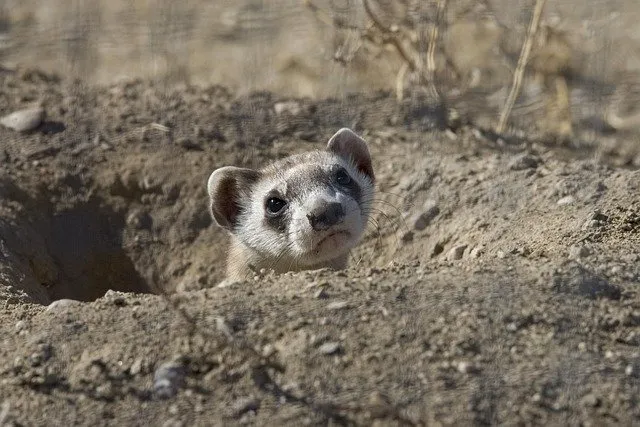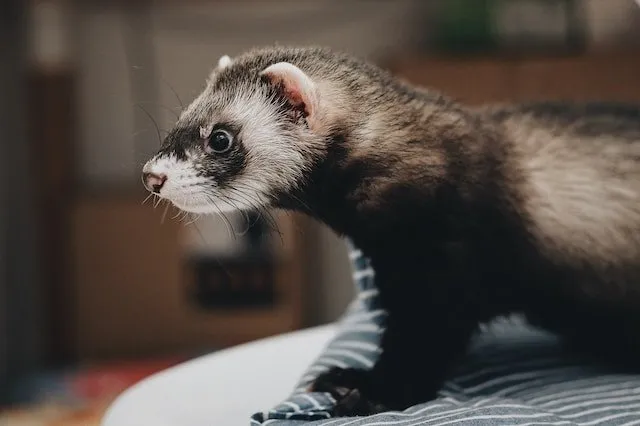As an Amazon Associate I earn from qualifying purchases.
The enigmatic black-footed ferret, a species whose existence was once on the brink of extinction, has long fascinated wildlife enthusiasts and conservationists alike. As these elusive creatures continue their slow but steady comeback from the brink of oblivion, one question consistently looms large in the minds of those eager to understand their lives and their chances of survival: What do black-footed ferrets eat?
This blog aims to unravel the mysteries of their dietary habits, exploring the menu items that sustain them and the critical role their diet plays in their journey toward recovery. Join us as we venture into these remarkable creatures’ worlds and uncover their sustenance secrets.
What Do Black-Footed Ferrets Eat?
The black-footed ferret, scientifically known as Mustela nigripes, is a fascinating and endangered animal inhabiting the North American continent. These small, nocturnal carnivores are primarily found in the Great Plains and have specific dietary requirements crucial to survival. In this blog, we will delve into the dietary habits of black-footed ferrets, exploring the foods they consume and why these items are essential for their well-being.
1. Prairie Dogs:
Black-footed ferrets are obligate carnivores, which means they primarily consume meat. Their highly specialized diet primarily consists of prairie dogs (Cynomys spp.). Prairie dogs are small, burrowing rodents that inhabit the same ecosystem as black-footed ferrets. These rodents make up nearly 90% of a black-footed ferret’s diet.
Prairie dogs are an excellent source of nutrition for black-footed ferrets due to their high protein content. These rodents are agile and fast, making them a challenging but essential prey for ferrets. Black-footed ferrets are highly adapted to hunting prairie dogs, using their keen sense of smell to locate burrows and their agility to catch their prey.
2. Ground Squirrels:
In addition to prairie dogs, black-footed ferrets also consume ground squirrels. Ground squirrels are smaller than prairie dogs but are still an important part of the ferret’s diet. They provide additional protein and energy sources to support the ferret’s active lifestyle.
3. Birds:
Black-footed ferrets are opportunistic hunters and may also feed on birds when the opportunity arises. Birds provide essential nutrients such as vitamins and minerals, diversifying their diet.
4. Insects:
While not a primary food source, insects can supplement a black-footed ferret’s diet. They are a source of essential vitamins and minerals, including B vitamins. Ferrets may consume insects when other prey is scarce.
5. Carrion:
In some instances, black-footed ferrets scavenge carrion, such as the remains of larger animals. Carrion can provide a valuable food source when live prey is scarce, ensuring the ferret’s survival during challenging times.
6. Water:
While not a food item, water is crucial for black-footed ferrets’ survival. They obtain water from their diet and may drink directly from water sources like streams or puddles.
How Do Hunt Black-Footed Ferrets Hunt Their Prey?
Black-footed ferrets are skilled and efficient hunters, employing several strategies and adaptations to capture their primary prey: prairie dogs. Their hunting techniques are finely tuned to match prairie dogs’ burrowing and elusive nature. Here’s a detailed look at how black-footed ferrets hunt their prey:
1. Nocturnal Behavior:
Black-footed ferrets are primarily nocturnal, meaning they are most active at night. This behavior helps them take advantage of the prairie dogs’ diurnal (daytime) activity patterns when they are most active and above ground.
2. Keen Sense of Smell:
Ferrets have an exceptional sense of smell, their primary tool for locating prairie dog burrows. They can detect the scent of prairie dogs from considerable distances, even when the rodents are hidden underground.
3. Stalking and Pouncing:
Once a black-footed ferret locates a prairie dog burrow, it quietly approaches the entrance. Ferrets are agile and patient stalkers. They may lie near the burrow entrance for extended periods, waiting for a prairie dog to emerge.
4. Surprise Attack:
When a prairie dog emerges from its burrow, the black-footed ferret will launch a rapid and surprise attack. Their sharp claws and teeth are their primary weapons in capturing prey. They are remarkably quick and agile, making them highly effective at catching the fast-moving prairie dogs.
5. Use of Burrows:
Black-footed ferrets have adapted to fit into prairie dog burrows, making pursuing their prey easier in the underground tunnels. They are slender and flexible, allowing them to navigate the narrow tunnels and corners of the caves.
6. Ruthless Efficiency:
Black-footed ferrets often target prairie dog colonies, where they can hunt multiple individuals in a single night. They will move from one burrow to another, systematically hunting and capturing prairie dogs. This efficiency helps them secure enough prey to sustain themselves and their potential offspring.
7. Specialized Diet:
Black-footed ferrets are obligate carnivores, meaning they must consume meat to survive. Prairie dogs are their primary food source because of their high protein content and availability in their habitat.
8. Scavenging:
In addition to hunting live prey, black-footed ferrets may scavenge carrion when available. This scavenging behavior helps them access food when live prey is scarce.
How Do Black-Footed Ferrets Help Our Ecosystem?
Black-footed ferrets play a vital role in their native ecosystems, and their presence has numerous positive impacts on the environment. Here are the detailed ways in which black-footed ferrets help support and maintain the health of their ecosystems:
1. Prairie Dog Population Control:
Black-footed ferrets serve as natural predators of prairie dogs, keystone species in grassland ecosystems. The ferrets’ predation helps regulate prairie dog populations, preventing overgrazing and habitat degradation. While prairie dogs play a role in soil aeration and plant growth through their burrowing activities, unchecked populations can lead to imbalances in the ecosystem. Black-footed ferrets contribute to maintaining a sustainable prairie dog population, resulting in a healthier and more diverse prairie ecosystem.
2. Biodiversity Maintenance:
Beyond their direct impact on prairie dog populations, black-footed ferrets indirectly benefit many other species within grassland ecosystems. By ensuring prairie dog populations are in check, ferrets help support the habitat and food sources of various plant and animal species. This, in turn, promotes overall biodiversity as these ecosystems provide diverse habitats for numerous wildlife species. The presence of black-footed ferrets aids in maintaining a balanced and thriving ecosystem.
3. Food Chain Dynamics:
Black-footed ferrets are an essential link in the grassland food chain. They serve as prey for larger predators like raptors and coyotes. By sustaining populations of black-footed ferrets, these larger predators also find a stable food source. This interdependence among species helps maintain the stability and health of the entire ecosystem. The presence of black-footed ferrets contributes to the intricate web of predator-prey relationships in grasslands.
4. Burrow Recycling:
Black-footed ferrets make use of prairie dog burrows as their dens. When ferrets abandon these caves, they become valuable shelters for various wildlife, including burrowing owls, snakes, and insects. This recycling of burrows is crucial for the ecosystem, as it reduces the need for new burrow excavation and conserves energy and resources. The utilization of abandoned burrows by multiple species creates a complex and interconnected web of ecological interactions.
5. Seed Dispersal:
While primarily carnivorous, black-footed ferrets may occasionally consume birds and small mammals. In doing so, they inadvertently aid in seed dispersal. Seeds from consumed plants can pass through their digestive systems and be deposited in different locations. This contributes to the dispersion of plant species and helps diversify the vegetation in the grassland ecosystem.
6. Ecosystem Resilience:
The presence of black-footed ferrets in an ecosystem is a vital indicator of its health and vitality. The decline or loss of this species can serve as an early warning sign of broader environmental issues. Conservation efforts aimed at protecting and reintroducing black-footed ferrets contribute to the survival of this endangered species and the preservation and health of the ecosystems they inhabit. By safeguarding the black-footed ferret, we promote overall ecosystem resilience and adaptability in the face of environmental changes.
Final Words
In exploring what black-footed ferrets eat, we’ve uncovered their role as ecological linchpins in the Great Plains. They prey on prairie dogs, controlling their populations and promoting healthy grasslands. This helps maintain biodiversity, supports the food chain, and recycles burrows for other wildlife. With their diet and behavior, Black-footed ferrets are indispensable stewards of their ecosystems, emphasizing the interconnectedness of all species in nature.
You can also read:
1.What Do Bettas Eat? Dive into Betta Fish Care
2.What Do Bengal Tigers Eat? Feasting in the Jungle
3.What Do Venus Flytraps Eat? A Detailed Guide to Their Carnivorous Diet
4.What Do Silverback Gorillas Eat? The Diet of Silverback Gorillas
Amazon and the Amazon logo are trademarks of Amazon.com, Inc, or its affiliates.



